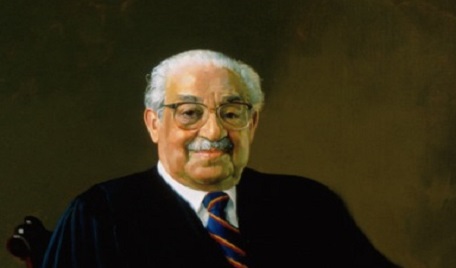On August 30, 1967, the Senate confirmed Thurgood Marshall as the first Black person to serve as a Supreme Court Justice. Marshall was no stranger to the Senate or the Supreme Court at the time.
 Marshall was confirmed in a 69-11 floor vote to join the Court. He had previously been confirmed by the Senate twice for two other government positions, first when Marshall was confirmed as a federal judge in the Kennedy administration and then as Solicitor General for President Lyndon Johnson.
Marshall was confirmed in a 69-11 floor vote to join the Court. He had previously been confirmed by the Senate twice for two other government positions, first when Marshall was confirmed as a federal judge in the Kennedy administration and then as Solicitor General for President Lyndon Johnson.
President Johnson nominated Marshall in June 1967 to replace the retiring Justice Tom Clark, who left the Court after his son, Ramsey Clark, became Attorney General. Johnson said Marshall was “best qualified by training and by very valuable service to the country. … I believe it is the right thing to do, the right time to do it, the right man and the right place.”
As a long-time civil rights litigator for the NAACP, Marshall had won most of the cases he argued in front of the Supreme Court in that capacity. Arguably his biggest win was the case of Brown v. Board of Education (1954), one of the true landmark decisions in the Court’s history, which invalidated the concept of segregation at public schools under the Fourteenth Amendment. “This Court should make it clear that that is not what our Constitution stands for,” Marshall argued successfully.
Marshall’s confirmation hearing met with some resistance from southern senators who were concerned about his liberal track record. The majority of Senators in the Judiciary Committee reported that Marshall “demonstrated those qualities which we admire in members of our highest judicial tribunal: thoughtfulness, care, moderation, reasonableness, a judicial temperament, and a balanced approach to controversial and complicated national problems.”
Five Senators, including Sam Ervin, a Democrat from North Carolina, didn’t recommend Marshall’s nomination. “It is clearly a disservice to the Constitution and the country to appoint a judicial activist to the Supreme Court at any time,” wrote Ervin in the committee’s report.
The actual debate and full floor vote on August 30, 1967, took about six hours, with the discussion focused on Marshall’s character and the conservative Senators’ concerns over Marshall as a liberal jurist and attorney. After he was finally approved by the Senate, Marshall then took two oaths, one in September 1967 and another in early October 1967 when he first joined the bench.
On the Court, Marshall was a member of the bench’s liberal wing. He served 24 years on the Court before retiring in 1991.
After Marshall’s death in 1993, the Court approved a special resolution honoring Marshall. “The great majority of Supreme Court Justices are almost always remembered for their contributions to constitutional law as a member of this Court. Justice Marshall, however, is unique because of his contributions to constitutional law before becoming a member of the Court were so significant,” wrote Chief Justice William Rehnquist. “Inscribed above the front entrance to this Court building are the words, ‘Equal Justice Under Law.’ Surely no individual did more to make these words a reality than Thurgood Marshall.”







